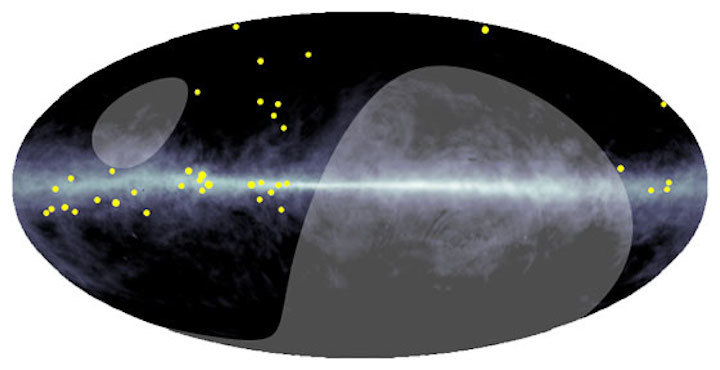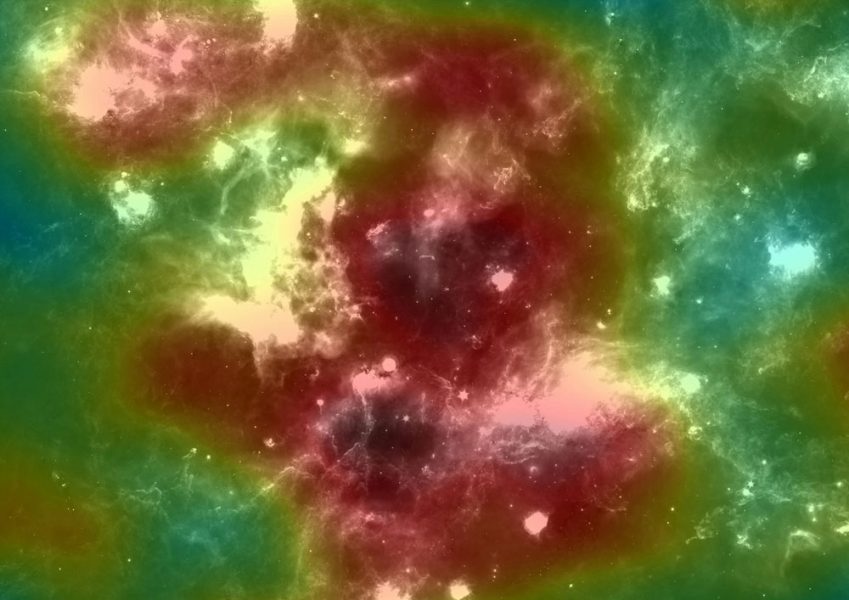4.04.2021
A Tibetan cosmic-ray observatory has discovered high-energy particle accelerators within our galaxy.
Move over, CERN. Unknown sources in the Milky Way dubbed “PeVatrons” accelerate protons to energies of a few peta-electronvolts – dozens of times higher than the yield of the Large Hadron Collider. Now, new data from a high-altitude experiment in Tibet confirm that such very-high-energy cosmic rays are indeed produced in our own galaxy.

APS; Background (atomic hydrogen distribution): HEASARC / LAMBDA / NASA / GFSC
“The results paint a much fuller picture of the PeVatron population in the Milky Way,” says Pat Harding (Los Alamos National Laboratory), who was not involved in the study.
The distribution of cosmic rays by energy suggests these particles come in two varieties. The most extreme ultra-high-energy cosmic rays (UHECRs) are believed to come from remote galaxies (see the May 2021 issue of Sky & Telescope to learn more about these harbingers). But the majority of cosmic rays, with energies below 4 PeV, are thought to originate in the Milky Way. However, the true nature of the PeVatron particle accelerators has remained unknown, largely because the paths of cosmic rays are bent by galactic magnetic fields, so they do not “point back” to their origin.
A large team of Chinese and Japanese scientists known as the Tibet ASγ Collaboration has now detected a few dozen very-high-energy (VHE) gamma rays from the Milky Way that aren’t associated with known sources. These gamma rays, collected between 2014 and 2017, are thought to be produced when cosmic rays slam into atomic nuclei in the interstellar medium. Theory says they carry about 10% of the original cosmic-ray energy. The most energetic one detected by the Tibet ASγ team packs a punch of 0.957 PeV – an all-time record.
Unlike cosmic rays, gamma ray photons do point back to their origin. So the fact that they’re concentrated toward the band of the Milky Way provides “strong evidence that cosmic rays are accelerated beyond PeV energies in our Galaxy and spread over the galactic disk,” the team wrote April 5th in Physical Review Letters (preprint available here).
“It’s a tantalizing detection,” says Petra Hüntemeyer (Michigan Tech). Both Hüntemeyer and Harding helped detect slightly less energetic (0.1 PeV) gamma rays from the Cygnus Cocoon – a superbubble surrounding a massive star-forming region. But according to Hüntemeyer, this new result is the first time that photons at even higher energies have been found not from a single source but throughout the Milky Way.

IFJ PAN / HAWC
The 30-year-old and ever-expanding Tibet ASγ experiment currently consists of some 700 scintillators spread over an area of 65,700 square meters (707,000 square feet) at an altitude of 4,300 meters (14,000 feet) near Yangbajing in Tibet. These air shower detectors register secondary particles that rain down when an energetic gamma ray smashes into a nitrogen or oxygen nucleus in Earth’s atmosphere. The data reveal both the energy and direction of the original gamma ray.
To distinguish gamma-ray-induced air showers from similar events produced by cosmic rays, the observatory also contains an underground array of 64 muon detectors. Because of a different decay process, gamma-ray-induced events contain far fewer muons, the heavy, short-lived cousins of electrons. The team sorts through and eventually dismisses 99.9999% of all detected air showers, leaving the very high-energy gamma-ray showers for analysis.
“This is really like looking for a needle in a haystack,” according to team member Kazumasa Kawata (University of Tokyo). At an American Physical Society press conference, Kawata added that the new observations support the idea that very-high-energy cosmic rays suffuse the galaxy. Produced over millions of years, these particles might even come from sources that aren’t active anymore.
“The sub-PeV gamma-ray photons that we detect may be like the fossil footprints of extinct dinosaurs,” says Masato Takita, another member of the Tibet ASγ group.

Institute of High Energy Physics of the Chinese Academy of Sciences
The Tibet results confirm that PeVatrons exist in our galaxy. But what are they? Supernova remnants have always been a popular candidate, but giant star-forming regions like the Cygnus Cocoon, the black hole at the galactic center, and energetic pulsars are other viable options. “It’s still possible that there are different PeVatron types,” says Hüntemeyer.
Scientists look forward to corroborating results from other facilities, like the Large High Altitude Air Shower Observatory (to be completed later this year in China), the future Cherenkov Telescope Array (with more than 100 telescopes at La Palma and in northern Chile), and the Southern Wide-field Gamma-ray Observatory (SWGO) that physicists hope to construct in South America.
“If we combine data from all of these experiments, we are beginning to get a comprehensive view of what our Galaxy looks like at the highest energies – in an energy range that was completely inaccessible prior to 2016 or so,” says Kelly Malone (Los Alamos National Laboratory). Harding agrees. “Upcoming facilities will have no shortage of interesting targets,” he says. “The high-energy sky still has many things to teach us about our Galaxy.”
Quelle: Sky&Telescope
